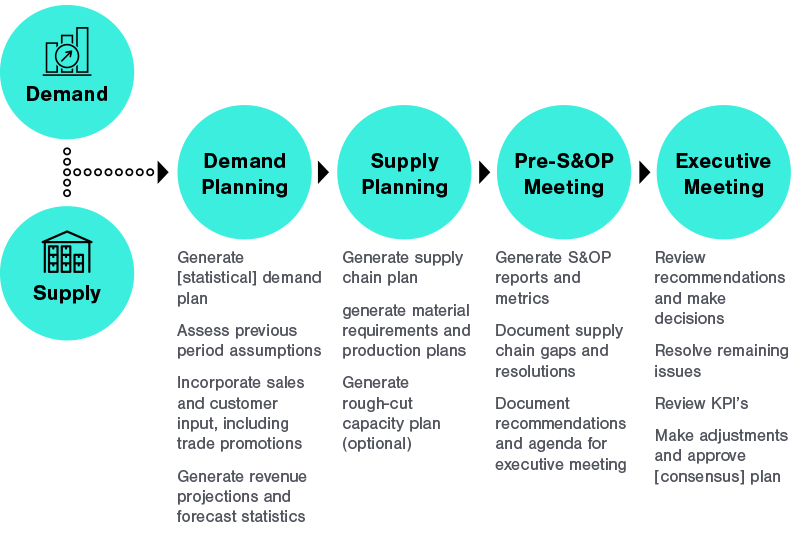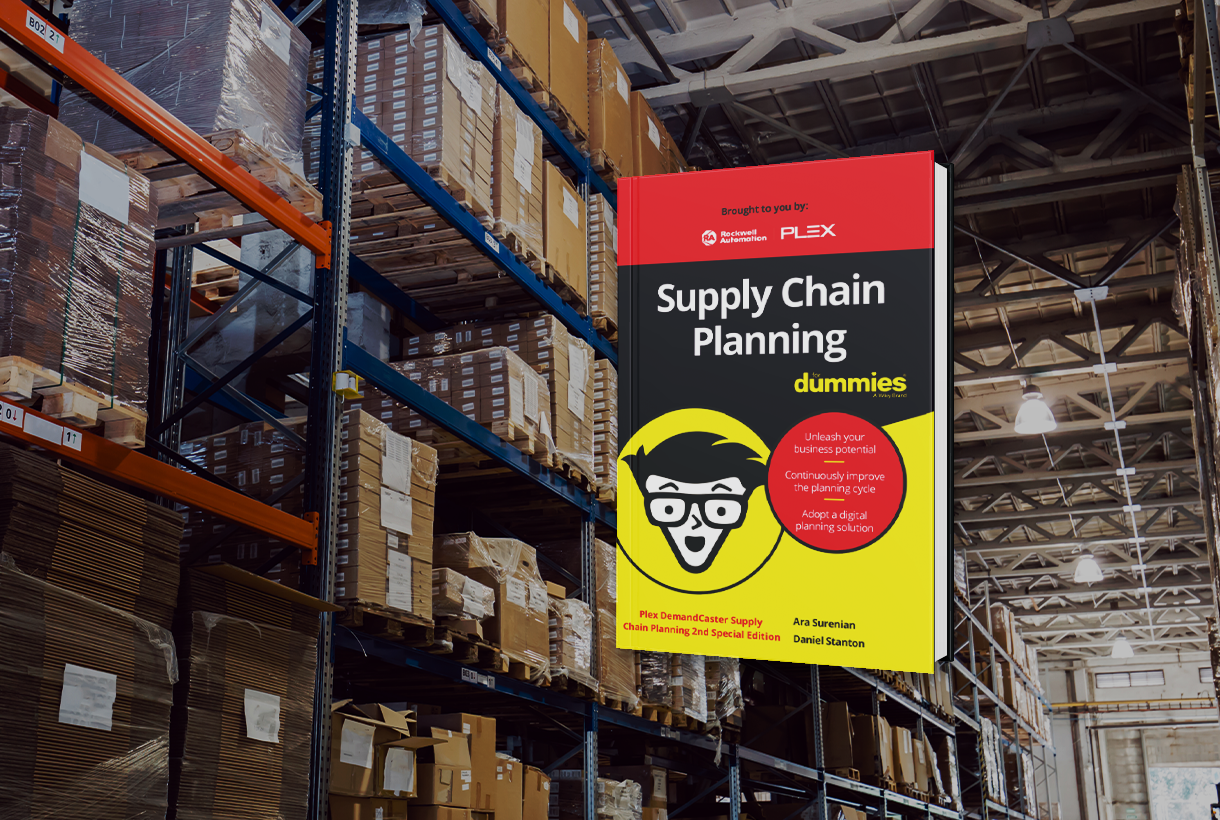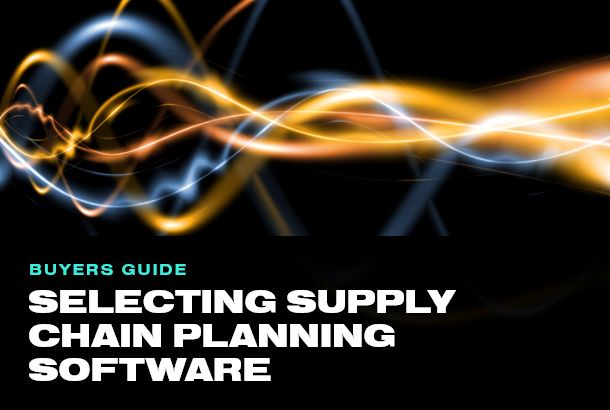Implementing Sales and Operations Planning (S&OP)
In our knowledge article What is S&OP?, we explained what sales and operations planning (S&OP) is and its many advantages. To sum up, S&OP is the creation of a unified, consensus-based business plan that enables organizations to control inventory costs while vastly improving service levels. In this article, we define a typical S&OP process and will explain how to implement the process.
According to IBF, S&OP is a process that coordinates different areas of the business to meet customer demand with the appropriate level of supply. When establishing your process, it is important to consider who will be responsible for each step of the process. You will also want to set expectations for hand-offs, meetings, and how you will communicate changes. Effective S&OP planning depends on the input. But it’s important to keep in mind that in order to move forward with a monthly S&OP plan, you must determine at which point in the month edits to the demand plan will no longer be allowed.
Use the following process overview as a template to define roles, responsibilities, and timing of each step after the close of each month. The steps and responsibilities should then be loaded into a shared calendar with reminders, meetings, and attendees (responsibility) scheduled. Steps that are not tied to the beginning of the month and are managed on an ongoing basis are noted with the designation: On-Going.
Typical S&OP Process

S&OP Roles and Responsibilities
Executive Management – CEO/Leader
- Chairs the executive S&OP meeting and serves as ultimate decision-making arbiter
- Holds organization accountable to plan
Is the primary contact for dispute resolution throughout the S&OP process
Sales & Marketing Leader
- Sets expectations with sales team members that they are going to perform sales forecasting and work to improve forecast accuracy
- Owns and speaks to sales performance and forecasts in the executive S&OP meeting
- Ensures that forecasting is a monthly (or periodic) process
Is the primary contact for issues related to strategic sales/customer decisions
Demand Planner
- Presents the demand plan information in a timely, accurate, ready-to-use condition
- Does some of the pre-plan analysis and statistical forecasting
- Interacts with sales to complete data collection and demand planning
- Focuses on issues and addresses any disconnections with the future forecast
Is the primary contact for issues related to roll-up of sales forecasts, analysis of forecasts and development of ultimate demand plan
Sales Personnel
- Gather intelligence from assigned customers and integrate findings into demand planning
- Perform sales forecasting for their assigned customers, markets or other sales segmentation
- Must know the actual vs. forecast performance for sales, the reasons, and the corrective actions
- Update the sales forecast monthly and speak to the above in the corporate sales review meeting
Each individual is the primary contact for issues related to sales forecasts for their particular customer and segments
Operations Leader
- Sets the expectation with the production and materials team that they will help with developing the supply plan according to the process and run to that plan
- Ensures the aggregate level data to be presented is linked to all of the derived detailed planning
- Chairs the monthly or periodic supply planning meeting
- Speaks to inventory and backlog performance versus forecast in the executive S&OP meeting
- Presents the actual vs. forecast performance for inventory
Is the primary contact for issues related to strategic operations/supply decisions
Supply Planning and Master Scheduling
- Updates the inventory plan monthly or periodically
- Maintains safety stocks, production rates, vendor performance, lead times and other supply planning attributes
- Speaks to the inventory detail in the supply planning meeting
- Reviews orders, due dates, and inventory and determines via analysis what to build, when to build, and where to build per the supply plan
Are the primary contacts for issues related to orders, inventory, and the supply planning process
TIP – Develop a RACI Matrix to quickly identify the roles and responsibilities of each individual/team in the S&OP process. Click here for a RACI Matrix template from IBF.
Step 1: Gather and Manage Data
This step entails the collection of data on past sales, trend analysis, and assessments of forecast accuracy. Advanced S&OP planning software can handle many of these tasks through automated data upload processes and built-in reporting. Additional data maintenance steps noted in the steps below must be performed manually on an ongoing basis, as needed.
The Demand Planner is typically responsible for leading this step in the process. Key inputs for this step will come from sales and marketing, but input from operations/supply, logistics, and finance should also be considered.
Sub-steps:
- Manage New Items or Existing Item Changes (On-Going). This includes linking an existing finished goods item to a new existing goods item, along with assigning new items to the planning hierarchy and entering dates for discontinued items.
- Run Analytics. If your supply chain planning solution provides an analytic function, run it at this point. As an example, go here to see how to run analytics in DemandCaster. Solutions such as DemandCaster also enable you to schedule analytics on an automated basis.
- Review Performance Measures. Determine which performance measures you wish to capture for planning purposes. Get appropriate input from sales and operations as needed.
- Adjust Item Level Supply Attributes. This entails:
-
- Setting appropriate supply policies, such as stocking requirements, lead times, etc., which should be reviewed monthly.
- Determining the type of supply planning to apply: Demand Chase or Level Load.
- Demand Chase means that supply increases and decreases with demand on a period-by-period basis.
- Level Loading means supply is level loaded between a beginning and ending inventory target.
Step 2: Develop Demand Plan
Demand planning includes validating forecasts, understanding sources of demand, accounting for variability, and revising customer service policies. Additionally, it encompasses the inclusion of promotion plans, one-time events, and new product and customer launches.
The Demand Planner will be responsible for developing the Demand Plan, but sales and marketing should be consulted for input and verification.
Sub Steps
- Create an S&OP Review Report. Supply chain planning software that has built-in reporting functionality enables you to run custom reports.
- Share Reports for Input (recommended). Distribute reports to sales or other participants to build consensus.
- Edit Demand Plans as Required. Incorporate input from performance measure reviews, any sales related information, and edit demand plans accordingly. Also consider establishing a freeze period that’s approximately equal to the longest cumulative lead-time be established to prevent editing of demand plans within that time period.
- Review and Finalize Consensus Demand Plan. This review takes place during the monthly demand planning review meeting with sales. It includes reviews of the past month’s performance and sales data, along with quantitative-based assumptions behind the numbers.
Step 3: Supply Planning
Supply planning involves translating the demand plan into an appropriate supply plan. Among its tasks are determining inventory targets, safety stock levels, and production methods for level loading and demand chase. It also includes assessing the ability to meet demand by reviewing available capacity, inventory, and operations scheduling.
Head of Supply will be responsible for the creation of the Supply Plan. Key staff from manufacturing, operations, logistics, and finance should be consulted for input and verification.
Step 4: Reconciliation of Plans | Pre-S&OP Meeting
This step occurs during the monthly pre-S&OP meeting. It entails sorting through supply-side issues to determine if the sales plan can be accommodated and inventory and backlog objectives can be met. Additional tasks include reviewing supply performance from the previous month and presenting forecasts.
The S&OP leader is typically responsible for the efficient execution of this meeting. Key participants include sales, marketing, operations, logistics, and finance.
Step 5: Approve and Release | Executive S&OP Meeting
Once the demand and supply plans are reconciled and finalized, the result is presented to the executive team during the monthly Executive S&OP meeting. The output of the meeting is an approved demand and supply plan that can be efficiently executed by operations.
The S&OP leader will oversee this meeting/step in the process, but the Executive Sponsor is a required participant and will be needed to finalize all decisions/outcomes of the meeting.
|
Sample Agenda for Executive S&OP Meeting Review S&OP calendar – critical dates S&OP aggregate summary
Last Month Performance – actual to plan review by category
Review 12-month rolling demand and supply plan by category including;
Summary of new action items Final approval |
S&OP carries enormous benefits in terms of lower inventory costs, higher productivity, and greater customer satisfaction. Top supply chain planning solutions, such as DemandCaster, increase advantages further still by enabling you to use the S&OP plan to drive requirements planning and also to move straight from planning to execution.


